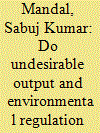| Srl | Item |
| 1 |
ID:
099234


|
|
|
|
|
| Publication |
2010.
|
| Summary/Abstract |
The aim of this paper is to examine the existence and direction of the causal relationship between energy consumption and output growth in the Indian cement industry for the period 1979-80 to 2004-05. The most recently developed panel unit root, a heterogeneous panel cointegration and panel-based error correction model, is applied within a multivariate framework. The empirical results confirm a positive, long-run cointegrated relationship between output and energy consumption when heterogeneous state effects are taken into account. We also found a long-run, bi-directional relationship between energy consumption and output growth in the Indian cement industry for the study period, implying that an increase in energy consumption directly affects the growth of this sector and that growth stimulates further energy consumption. These empirical findings imply that energy consumption and output are jointly determined and affect each other. The empirical evidence also suggests the implementation of energy conservation policies oriented toward improving energy-use efficiency to avoid any negative impacts of the conservation policies on the growth of this industry.
|
|
|
|
|
|
|
|
|
|
|
|
|
|
|
|
| 2 |
ID:
098681


|
|
|
|
|
| Publication |
2010.
|
| Summary/Abstract |
Energy use in the production of desirable output often results in the generation of undesirable emission with detrimental impact on the environment, and whose disposal is frequently monitored by public authorities. Previous studies, however, paid little attention to undesirable output and environmental regulation related to its disposal while estimating energy use efficiency. Analysis of energy efficiency ignoring undesirable output could result in biased estimates of efficiency. Thus the aim of this paper is to estimate energy use efficiency in the presence of energy related undesirable emission by taking Indian cement industry as a suitable context of my analysis. Depending on the presence and absence of undesirable output and environmental regulation, three measures of efficiency have been estimated at the state level from 2000-01 to 2004-05 by applying Data Envelopment Analysis. Energy efficiency is defined as the ability of the producer to reduce the energy input to the largest extent possible, conditional on the given level of output and non-energy inputs. Empirical results reveal that energy efficiency estimates are biased if only desirable output is considered. Results also demonstrate that environmental regulation has a reinforcing effect on energy use efficiency.
|
|
|
|
|
|
|
|
|
|
|
|
|
|
|
|
| 3 |
ID:
094396


|
|
|
|
|
| Publication |
2010.
|
| Summary/Abstract |
Coal combustion, for the production of cement, generates considerable amount of environmentally detrimental carbon dioxide as an undesirable by-product. Thus, this paper aims at measuring environmental efficiency within a joint production framework of both desirable and undesirable output using Data Envelopment Analysis and Directional Distance Function. Carbon dioxide is considered as an input in one context and as an undesirable output in the other with the environmental efficiency being defined accordingly. Using 3 digit sate level data from the Annual Survey of Industries for the years 2000-2001 through 2004-2005, the proposed models are applied to estimate environmental efficiency of Indian cement industry. Empirical results show that there is enough potential for the industry to improve its environmental efficiency with efficiency being varied across states. Results also show that Indian cement industry, if faced with environmental regulation, has the potential to expand desirable output and contract undesirable output with the given inputs. However, regulation has a potential cost in terms of lower feasible expansion of desirable output as compared to unregulated scenario.
|
|
|
|
|
|
|
|
|
|
|
|
|
|
|
|